Prediction of Potassium in Peach Leaves Using Hyperspectral Imaging and Multivariate Analysis
Abstract
:1. Introduction
Hyperspectral Imaging vs. Digital Color Imaging
2. Materials and Methods
2.1. Field Data Collection
2.2. The Imaging System
2.3. Hyperspectral Data Collection
2.4. Data Processing and Modeling
3. Results and Discussion
3.1. Principal Component Analysis
3.2. Partial Least Square Analysis
4. Conclusions
Author Contributions
Funding
Institutional Review Board Statement
Informed Consent Statement
Data Availability Statement
Acknowledgments
Conflicts of Interest
References
- Tranker, M.; Tavakol, A.; Jakli, B. Functioning of K and Magnesium in photosynthesis, photosynthate translocation and photoprotection. Physiol. Plant 2018, 163, 414–431. [Google Scholar] [CrossRef] [PubMed] [Green Version]
- Wang, C.; Li, X.; Wang, L.; Yang, C.; Chen, X.; Li, M.; Li, M.; Ma, S. Prediction of N, P and K contents in Sugarcane Leaves by Vis-NIR Spectrocopty and Modeling of NP Interactons Effects. Trans. ASABE 2019, 62, 1427–1433. [Google Scholar] [CrossRef]
- Kuzin, A.; Solovchenko, A. Essential Role of Potassium in Apple and Its Implications for Management of Orchard Fertilization. Plants 2021, 10, 2624. [Google Scholar] [CrossRef] [PubMed]
- Weksler, S.; Rozenstein, O.; Haish, N.; Moshelion, M.; Wallach, R.; Ben-Dor, E. Detection of Potassium Deficiency and Momentary Transpiration Rate Estimation at Early Growth Stages Using Proximal Hyperspectral Imaging and Extreme Gradient Boosting. Sensors 2021, 21, 958. [Google Scholar] [CrossRef]
- Bustamante, M.; Muñoz, A.; Romero, I.; Osorio, P.; Mánquez, S.; Arriola, R.; Reyes-Díaz, M.; Ribera-Fonseca, A. Impact of Potassium Pre-Harvest Applications on Fruit Quality and Condition of Sweet Cherry (Prunus avium L.) Cultivated under Plastic Covers in Southern Chile Orchards. Plants 2021, 10, 2778. [Google Scholar] [CrossRef]
- Torabian, S.; Farhangi-Abriz, S.; Qin, R.; Noulas, C.; Sathuvalli, V.; Charlton, B.; Loka, D.A. Potassium: A Vital Macronutrient in Potato Production—A Review. Agronomy 2021, 11, 543. [Google Scholar] [CrossRef]
- Ghanem, M.; Ben Mimoun, M. Effects of potassium foliar sprays on Royal Glory peach trees. Acta Hortic. 2010, 868, 261–266. [Google Scholar] [CrossRef]
- Zhai, Y.; Cui, L.; Zhou, X.; Gao, Y.; Fei, T.; Gao, W. Estimation of Nitrogen, Phosphorous, and Potassium contents in the leaves of differnet plants using laboratory-based visible and near-infrared reflectance spectroscopy: Comparison of partial least square regression and support vector machine regression methods. Int. J. Remote Sens. 2013, 34, 2502–2518. [Google Scholar]
- Rotbart, N.; Schmilovitch, Z.; Cohen, Y.; Alchanatis, V.; Erel, R.; Ignat, T.; Shenderey, C.; Dag, A.; Yermiyahu, U. Estimation of olive leaf nitrogen concentration using visible and near-infrared spectral reflectance. Biosyst. Eng. 2013, 114, 426–434. [Google Scholar] [CrossRef]
- Alchanatis, V.; Schmilovitch, Z.; Meron, M. In-field assessment of single leaf nitrogen status by spectral reflectance measurements. Precis. Agric. 2005, 6, 25–39. [Google Scholar] [CrossRef]
- Cohen, Y.; Alchanatis, V.; Zusman, Y.; Dar, Z.; Bonfil, D.J.; Karnieli, A.; Zilberman, A.; Moulin, A.; Ostrovsky, V.; Levi, A.; et al. Leaf nitrogen estimation in potato based on spectral data and on simulated bands of the Venus Satellite. Precis. Agric. 2010, 11, 520–537. [Google Scholar] [CrossRef]
- Min, M.; Lee, W.S.; Kim, Y.H.; Bucklin, R.A. Nondestructive detection of nitrogem in Chinese cabbage leaves using VIS-NIR spectroscopy. HortScience 2006, 41, 162–166. [Google Scholar] [CrossRef] [Green Version]
- Saranga, Y.; Landa, A.; Shekel, Y.; Bosak, A.; Kafkafi, U. Near-infrared analysis of cotton leaves as a guide for nitrogen fertilization. Agron. J. 1998, 90, 16–21. [Google Scholar] [CrossRef]
- Thomas, J.; Gausman, H. Leaf reflectance vs. leaf chlorophyll and carotenoid concentrations for eight crops. Agron. J. 1977, 69, 799–802. [Google Scholar] [CrossRef]
- Siedliska, A.; Baranowski, P.; Pastuszka-Wozniak, J.; Zubik, M.; Krzyszczak, J. Identification of plant leaf phosphorous content at different growth stages based on hyperspectral reflectance. BMC Plant Biol. 2021, 21, 28. [Google Scholar] [CrossRef]
- Kamruzzaman, M.; ElMasry, G.; Sun, D.-W.; Allen, P. Prediction of some quality attributes of lamb meat using near-infrared hyperspectral imaging and multivariate analysis. Anal. Chim. Acta 2012, 714, 57–67. [Google Scholar] [CrossRef]
- Zhang, X.; Liu, F.; He, Y.; Gong, X. Detecting macronutrients content and distribution in oilseed rape leaves based on hyperspectral imaging. Biosyst. Eng. 2013, 115, 56–65. [Google Scholar] [CrossRef]
- Shimoni, M.; Haelterman, R.; Perneel, C. Hypersectral Imaging for Military and Security Applications: Combining Myriad Processing and Sensing Techniques. IEEE Geosci. Remote Sens. Mag. 2019, 7, 101–117. [Google Scholar] [CrossRef]
- Briottet, X.; Boucher, Y.; Dimmeler, A.; Malaplate, A.; Cini, A.; Diani, M.; Bekman, H.; Schwering, P.; Skauli, T.; Kasen, I.; et al. Military applications of hyperspectral imagery. In Targets and Backgrounds XII: Characterization and Representation; International Society for Optics and Photonics: Bellingham, WA, USA, 2006; Volume 6239, pp. 82–89. [Google Scholar]
- Sankaran, S.; Mishra, A.; Maja, J.M.; Ehsani, R. Visible-near infrared spectroscopy for detection of Huanglongbing in citrus orchards. Comput. Electron. Agric. 2011, 77, 127–134. [Google Scholar] [CrossRef]
- Sankaran, S.; Maja, J.M.; Buchanon, S.; Ehsani, R. Huanglongbing (Citrus Greening) Detection Using Visible, Near Infrared and Thermal Imaging Techniques. Sensors 2013, 13, 2117–2130. [Google Scholar] [CrossRef] [Green Version]
- Jung, A.; Vohland, M.; Thiele-Bruhn, S. Use of A Portable Camera for Proximal Soil Sensing with Hyperspectral Image Data. Remote Sens. 2015, 7, 11434–11448. [Google Scholar] [CrossRef] [Green Version]
- Steffens, M.; Kohlpaintner, M.; Buddenbaum, H. Fine spatial resolution mapping of soil organic matter quality in a Histosol profile. Eur. J. Soil Sci. 2014, 65, 827–839. [Google Scholar] [CrossRef]
- Cheng, W.; Sun, D.W.; Pu, H.; Wei, Q. Chemical spoilage extent traceability of two kinds of processed pork meats using one multispectral system developed by hyperspectral imaging combined with effective variable selection methods. Food Chem. 2017, 221, 1989–1996. [Google Scholar] [CrossRef] [PubMed]
- Peng, Y.; Zhao, L.; Hu, Y.; Wang, G.; Wang, L.; Liu, Z. Prediction of Soil Nutrient Contents Using Visible and Near-Infrared Reflectance Spectroscopy. ISPRS Int. J. Geo-Inf. 2019, 8, 437. [Google Scholar] [CrossRef] [Green Version]
- Xie, Y.; Plett, D.; Liu, H. The Promise of Hyperspectral Imaging for the Early Detection of Crown Rot in Wheat. AgriEngineering 2021, 3, 924–941. [Google Scholar] [CrossRef]
- Mee, C.; Balasundram, S.; Hanif, A.H. Detecting and Monitoring Plant Nutrient Stress Using Remote Sensing Approaches: A Review. Asian J. Plant. Sci. 2017, 16, 1–8. [Google Scholar]
- What is Hyperspectral Imaging? Available online: https://www.middletonspectral.com/resources/what-is-hyperspectral-imaging/ (accessed on 11 February 2022).
- HSC-2 Hyperspectral Camera. Available online: https://senop.fi/wp-content/uploads/senop-hsc-2-hyperspectral-camera-V3iAWSvw.pdf (accessed on 11 February 2022).
- Savitzky, A.; Golay, M.J. Smoothing and differentiation of data by simplified least squares procedures. Anal. Chem. 1964, 36, 1627–1639. [Google Scholar] [CrossRef]
- Dhanoa, M.S.; Lister, S.J.; Sanderson, R.; Barnes, R.J. The link between multiplicative scatter correction (MSC) and standard normal variate (SNV) transformations of NIR spectra. J. Near-Infrared Spectros 1994, 2, 43–47. [Google Scholar] [CrossRef]
- Schafer, R.W. What Is a Savitzky-Golay Filter? [Lecture Notes]. IEEE Signal Process. Mag. 2011, 28, 111–117. [Google Scholar] [CrossRef]
- Lohringer, H. Fundamental of Statistics. Available online: http://www.statistics4u.info/fundstat_eng/index.html (accessed on 2 April 2022).
- Geladi, P.; MacDougall, D.; Martens, H. Linearization and Scatter-Correction for Near-Infrared Reflectance Spectra of Meat. Appl. Spectrosc. 1985, 39, 491–500. [Google Scholar] [CrossRef]
- Meacham-Hensold, K.; Montes, C.M.; Wu, J.; Guan, K.; Fu, P.; Ainsworth, E.; Pederson, T.; Moore, C.; Brown, K.L.; Raines, C.; et al. High-throughput field phenotyping using hyperspectral reflectance and partial least squares regression (PLSR) reveals genetic modifications to photosynthetic capacity. Remote Sens. Environ. 2019, 231, 111176. [Google Scholar] [CrossRef] [PubMed]
- Wu, D.; Nie, P.C.; Cuello, J.; He, Y.; Wang, Z.P.; Wu, H.X. Application of visible and near infrared spectroscopy for rapid and non-invasive quantification of common adulterants in Spirulina powder. J. Food Eng. 2011, 102, 278–286. [Google Scholar] [CrossRef]
- Gallardo-Velazquez, T.; Osorio-Revilla, G.; Loa, M.Z.; Rivera-Espinoza, Y. Application of FTIR-HATR spectroscopy and multivariate analysis to the quantification of adulterants in Mexican honeys. Food Res. Int. 2009, 42, 313–318. [Google Scholar] [CrossRef]
- Heckmann, D.; Schlüter, U.; Weber, A.P.M. Machine learning techniques for predicting crop photosynthetic capacity from leaf reflectance spectra. Mol. Plant 2017, 10, 878–890. [Google Scholar] [CrossRef] [PubMed] [Green Version]
- Yendrek, C.; Tomaz, T.; Montes, C.M.; Cao, Y.; Morse, A.M.; Brown, P.J.; McIntyre, L.; Leakey, A.; Ainsworth, E. High-throughput phenotyping of maize leaf physiology and biochemistry using hyperspectral reflectance. Plant Physiol. 2017, 173, 614–626. [Google Scholar] [CrossRef] [PubMed]
- Silva-Perez, V.; Molero, G.; Serbin, S.P.; Condon, A.G.; Reynolds, M.P.; Furbank, R.T.; Evans, J.R. Hyperspectral reflectance as a tool to measure biochemical and physiological traits in wheat. J. Exp. Bot. 2018, 69, 483–496. [Google Scholar] [CrossRef] [Green Version]

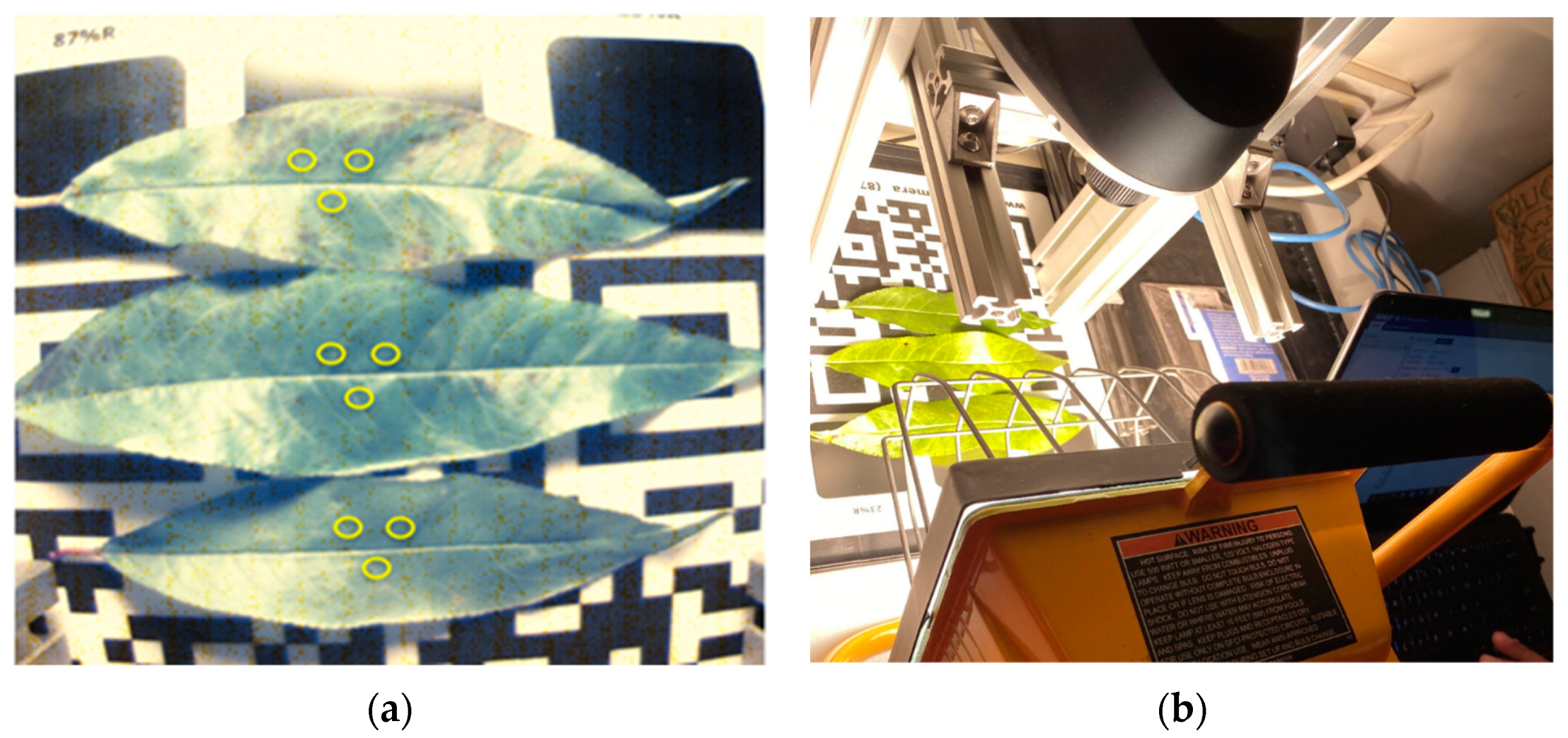
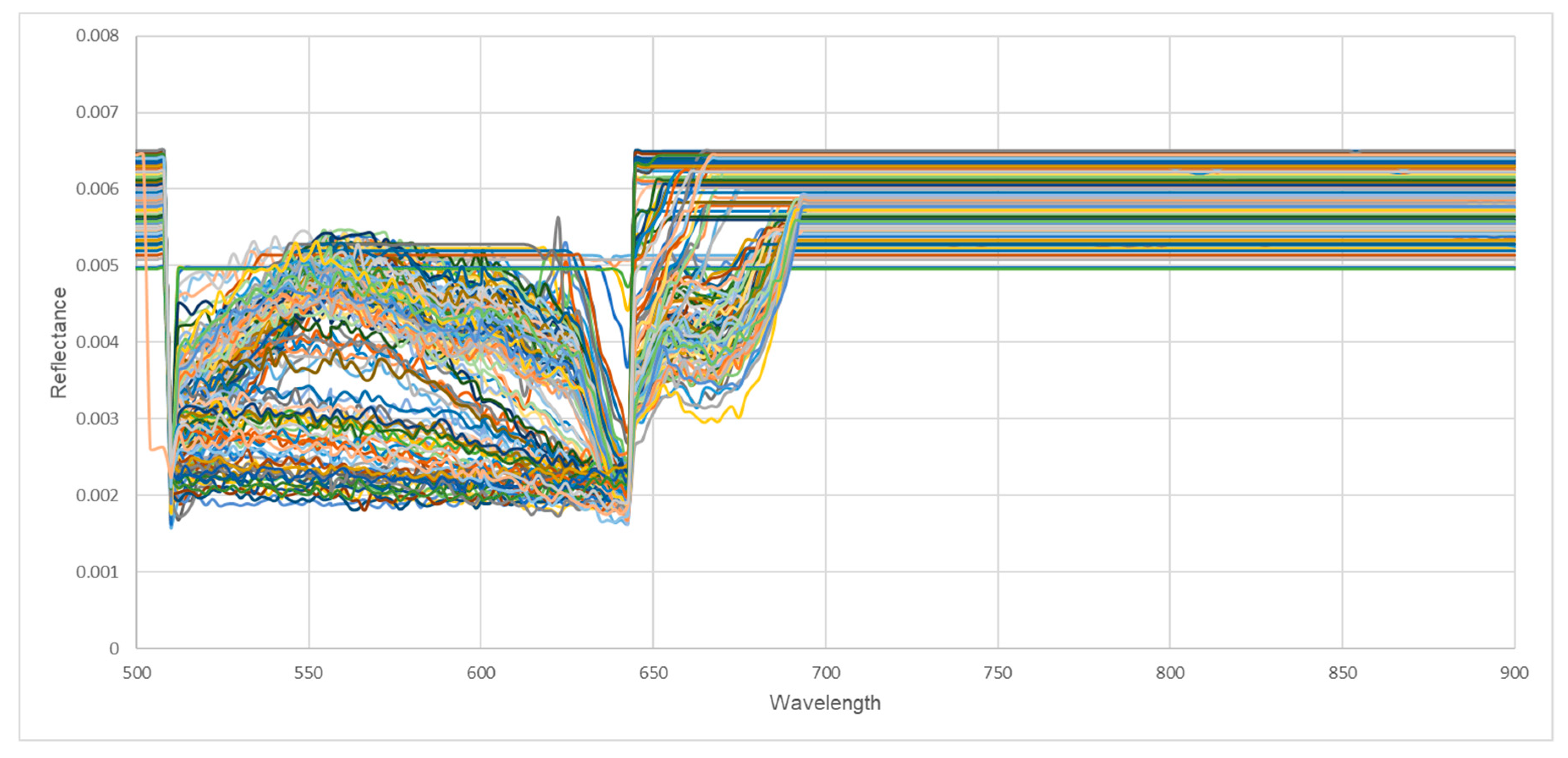


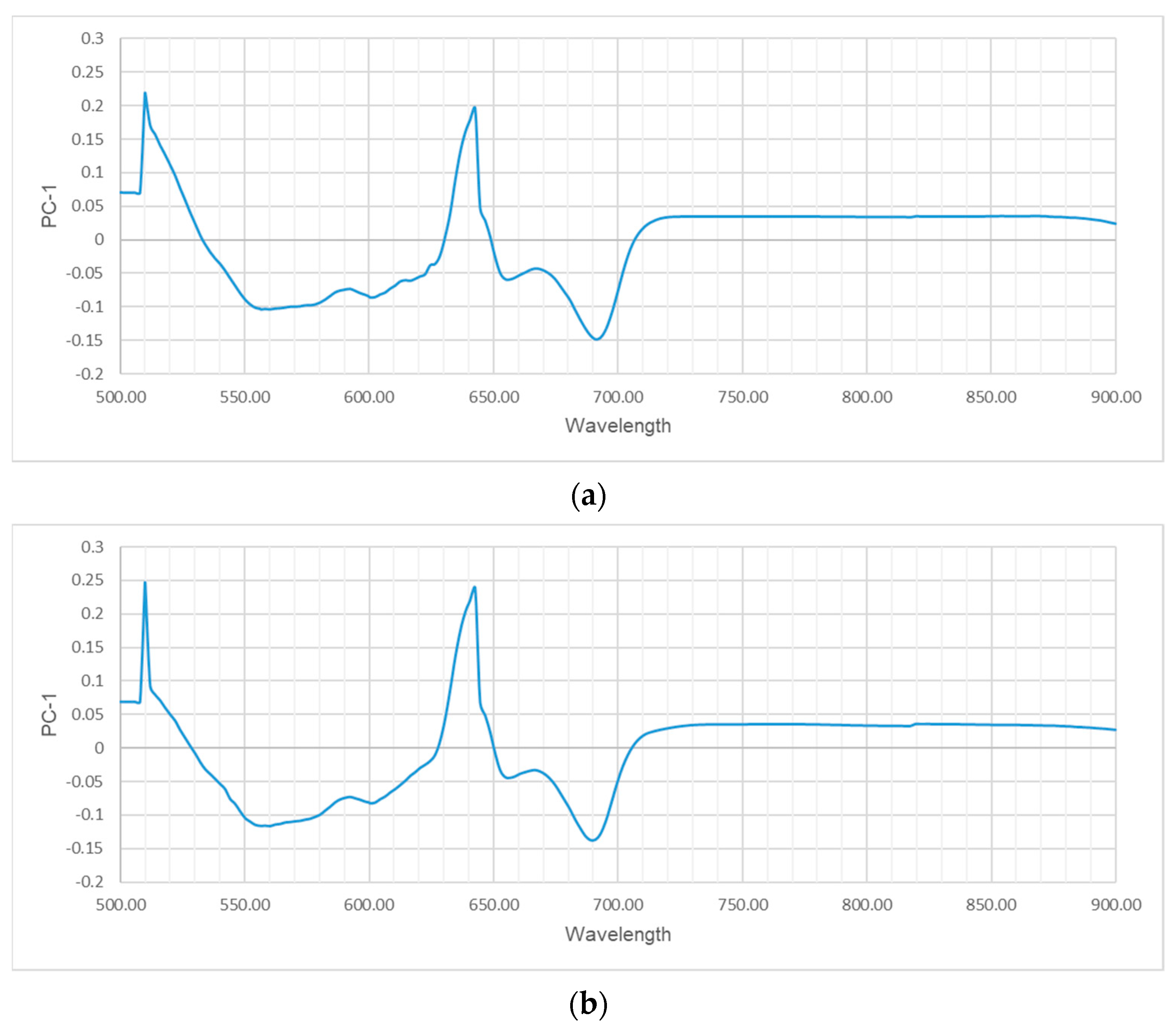
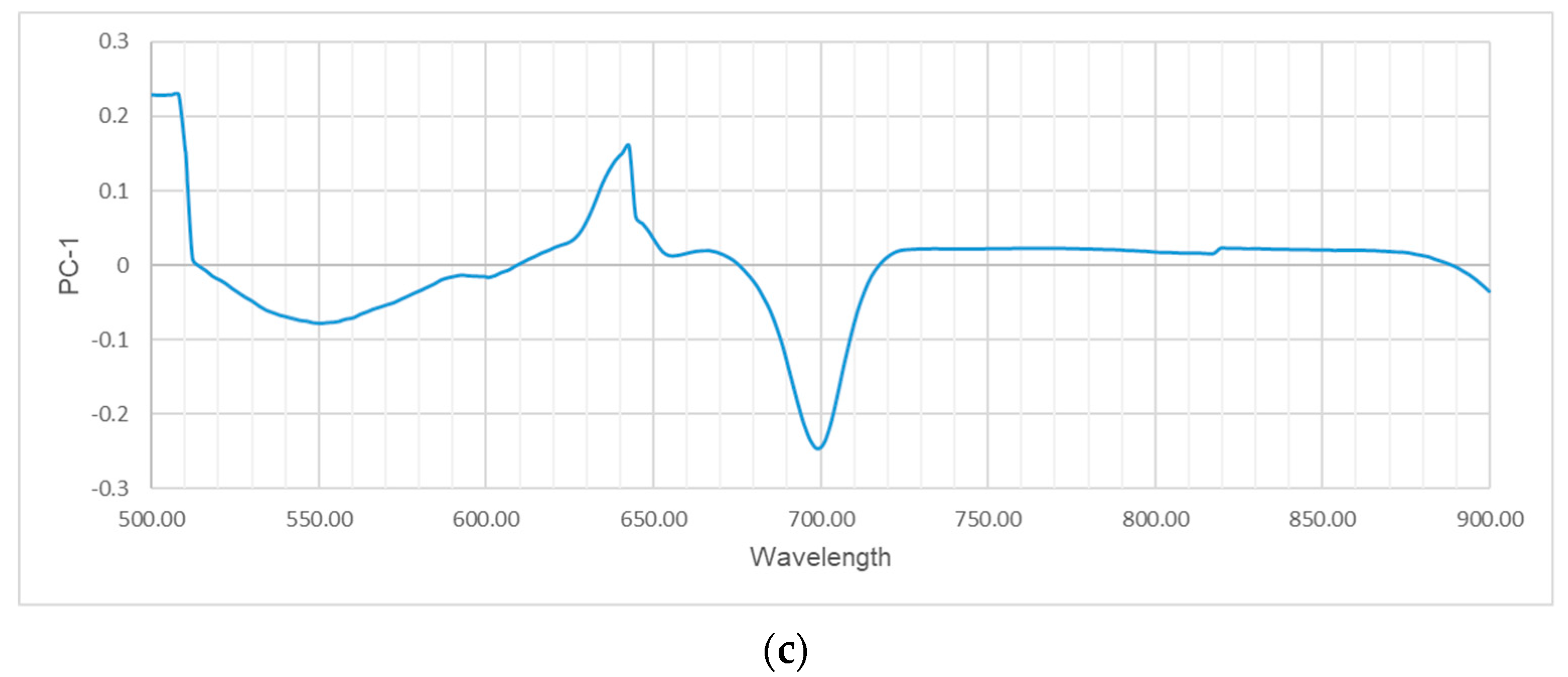
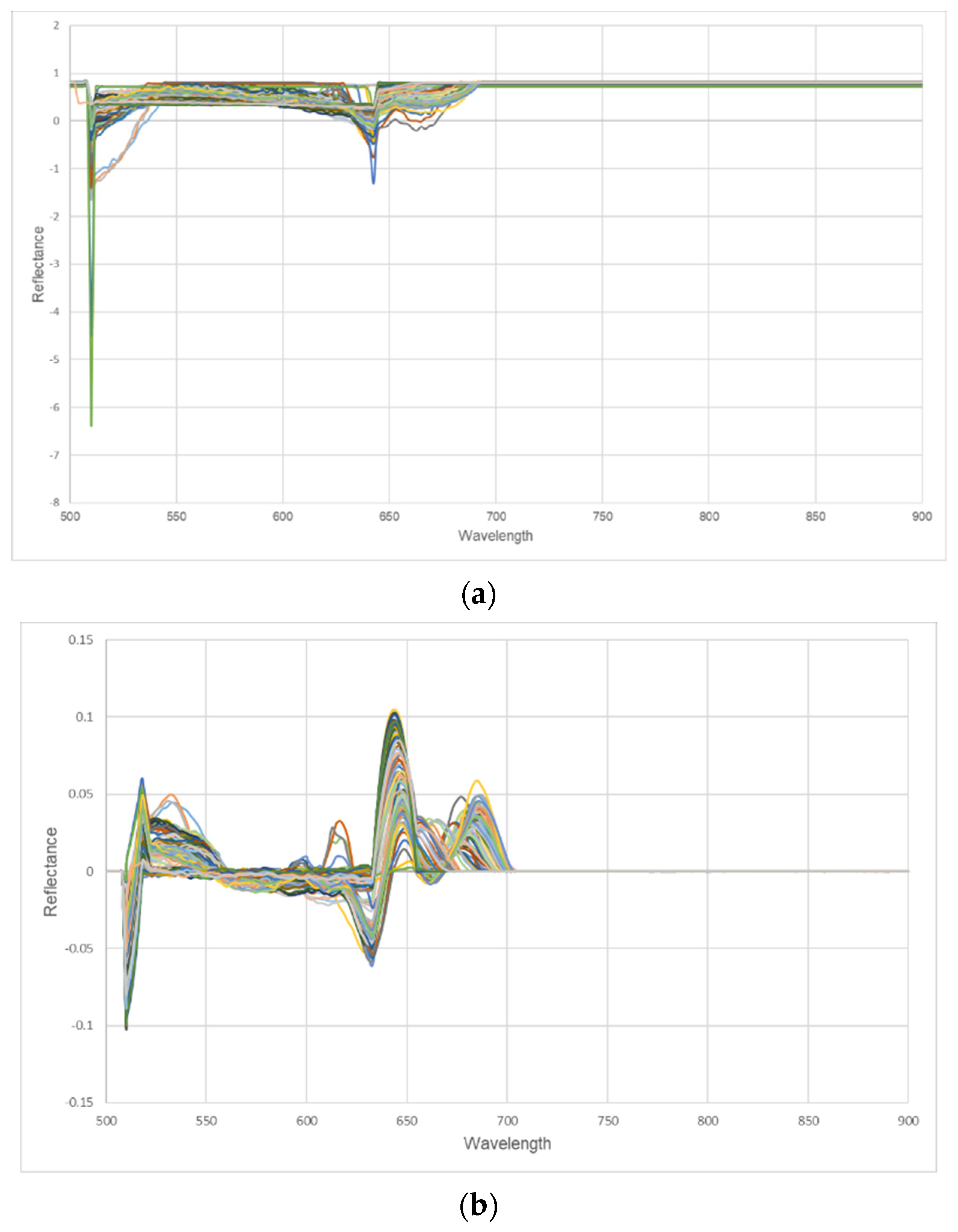
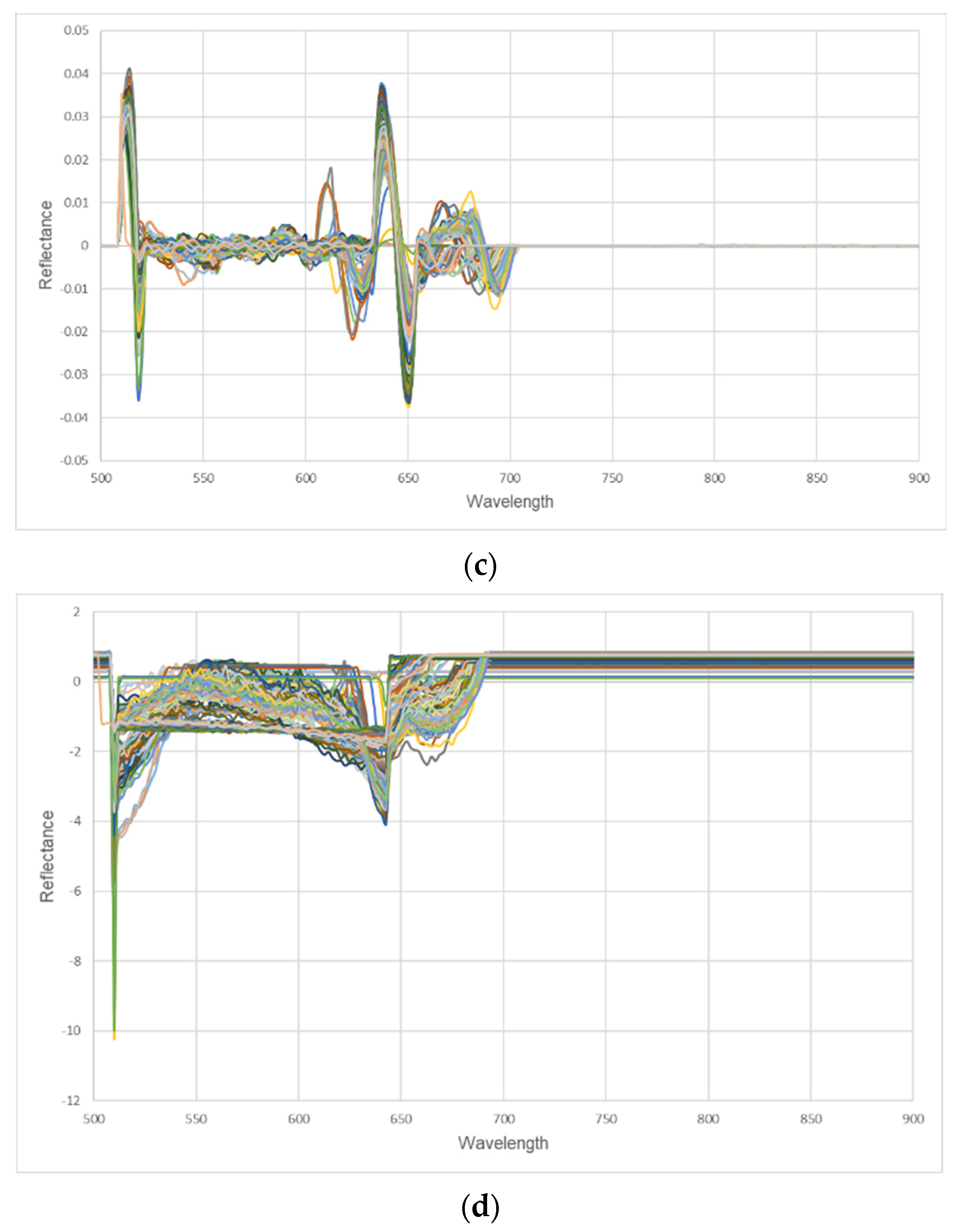
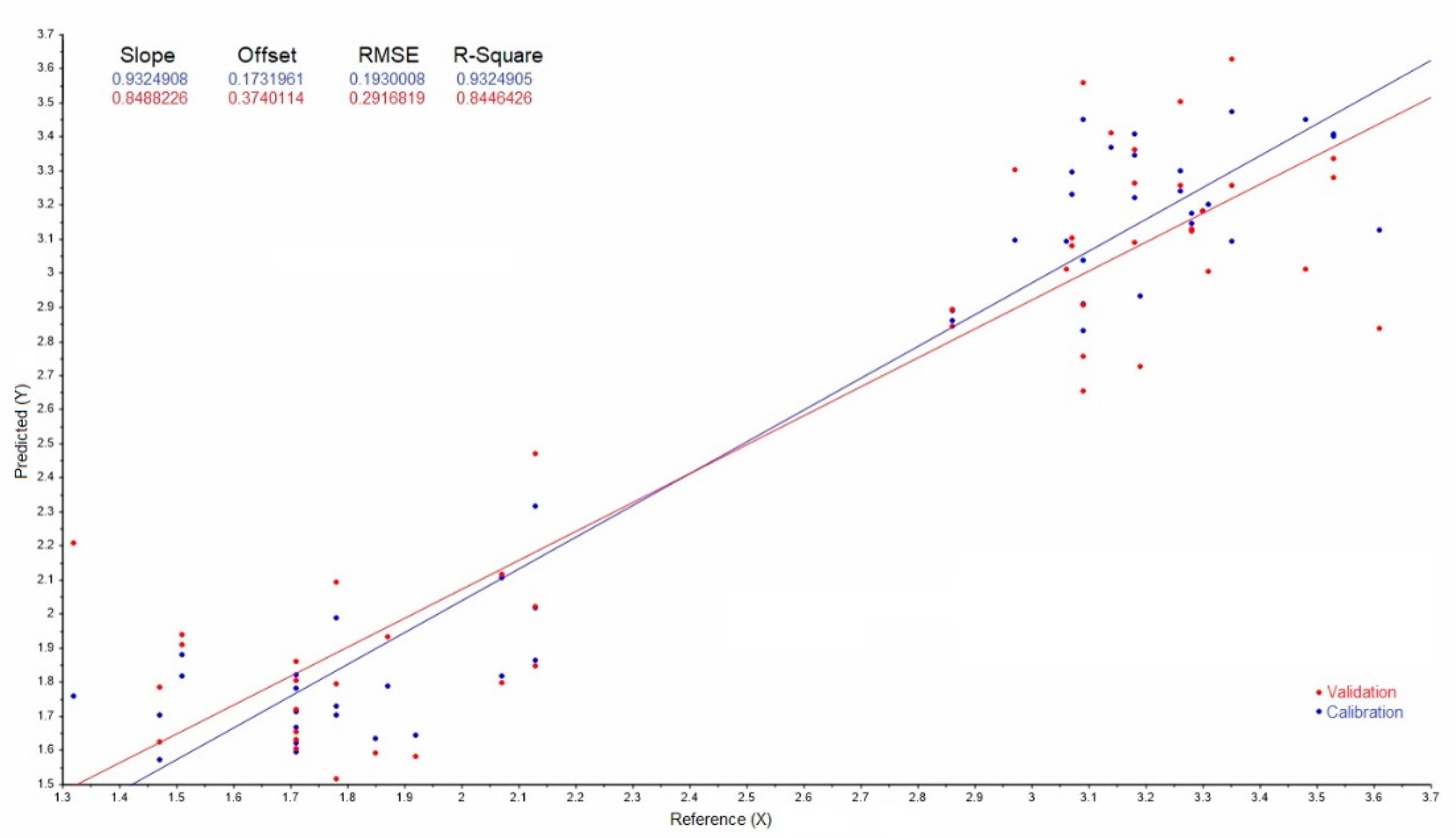
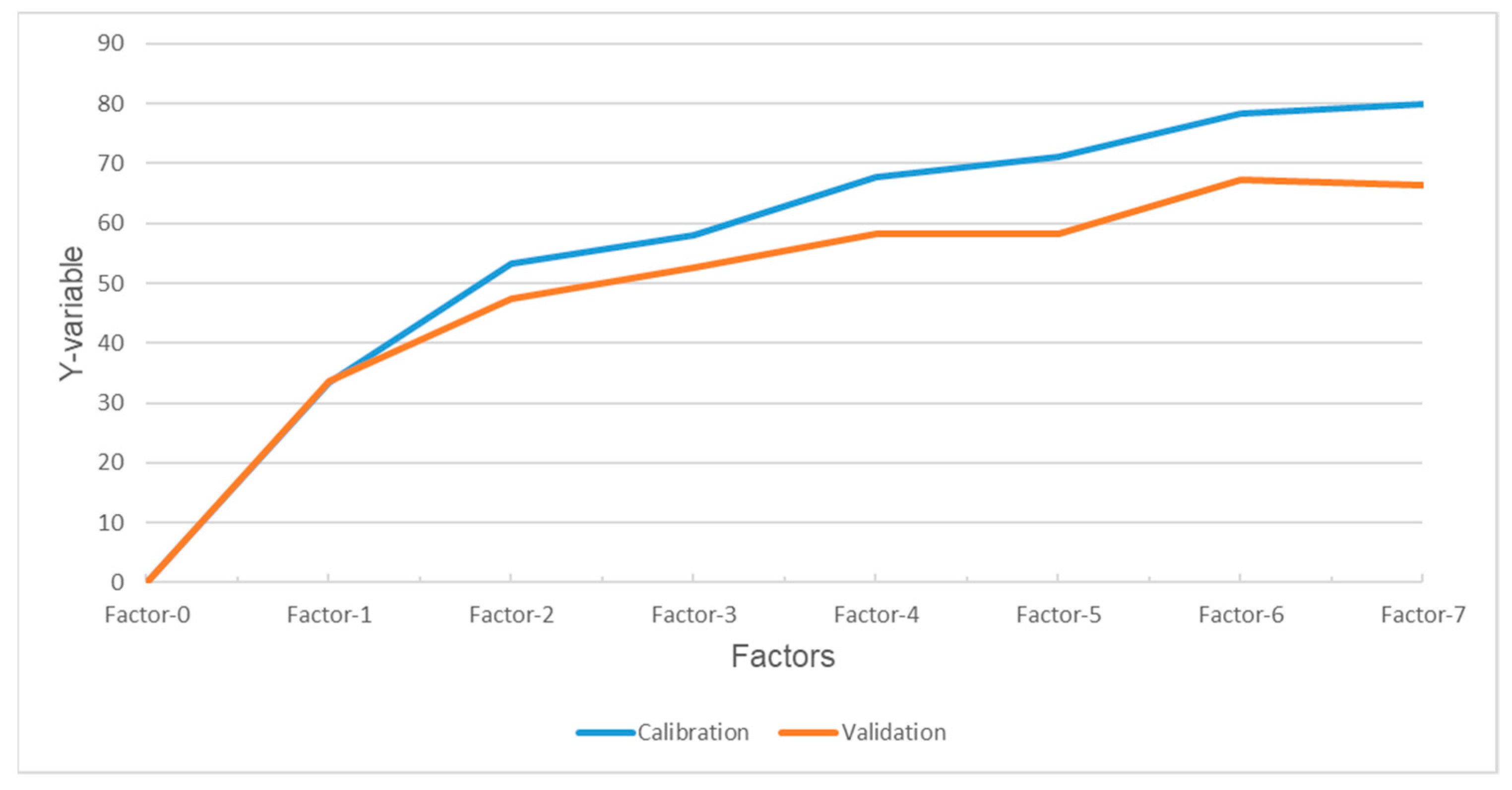
| Bag Name | No. of Samples | Tree No. | Orchard No. 1 | K Nutrient Concentration 2 |
|---|---|---|---|---|
| H1_T1_B1 | 15 | 1 | P24K1 | High |
| H1_T1_B2 | 15 | 1 | P24K1 | High |
| H1_T1_B3 | 15 | 1 | P24K1 | High |
| H1_T2_B1 | 15 | 2 | P24K1 | High |
| H1_T2_B2 | 15 | 2 | P24K1 | High |
| H1_T2_B3 | 15 | 2 | P24K1 | High |
| H1_T3_B1 | 15 | 3 | P24K1 | High |
| H1_T3_B2 | 15 | 3 | P24K1 | High |
| H1_T3_B3 | 15 | 3 | P24K1 | High |
| M3_T1_B1 | 15 | 1 | P24K3 | Medium |
| M3_T1_B2 | 15 | 1 | P24K3 | Medium |
| M3_T1_B3 | 15 | 1 | P24K3 | Medium |
| M3_T2_B1 | 15 | 2 | P24K3 | Medium |
| M3_T2_B2 | 15 | 2 | P24K3 | Medium |
| M3_T2_B3 | 15 | 2 | P24K3 | Medium |
| M3_T3_B1 | 15 | 3 | P24K3 | Medium |
| M3_T3_B2 | 15 | 3 | P24K3 | Medium |
| M3_T3_B3 | 15 | 3 | P24K3 | Medium |
| L3_T1_B1 | 17 | 1 | 15 | Low |
| L3_T1_B2 | 17 | 1 | 15 | Low |
| L3_T1_B3 | 16 | 1 | 15 | Low |
| L3_T2_B1 | 17 | 2 | 15 | Low |
| L3_T2_B2 | 17 | 2 | 15 | Low |
| L3_T2_B3 | 16 | 2 | 15 | Low |
| L3_T3_B1 | 17 | 3 | 15 | Low |
| L3_T3_B2 | 17 | 3 | 15 | Low |
| L3_T3_B3 | 16 | 3 | 15 | Low |
| Parameters | Specifications |
|---|---|
| Spectral Range | 400–1000 nm |
| Spectral FWHM | 5–10 nm |
| Spectral Step | 0.1 nm |
| Spectral Bands | up to 1000 |
| Horizontal FOV | 36.8° |
| Vertical FOV | 36.8° |
| Image Sensor | CMOS |
| Dynamic Range | 10–12 bits |
| Max Image Rate (frames/s) | 74 (12 bit) |
| 149 (10 bit) | |
| Image Resolutions | 1024 × 1024 |
| Exposure time | Adjustable |
| Memory | 1TB |
| GigE RJ-45 | |
| USB 2.0 type-C | |
| Connections | Mini-Displayport v1.2 |
| IO port with UART and 4GPIO pins | |
| MMCX for external GPS antenna (if needed) | |
| Weight | 986 g |
| Dimensions (l × w × h) | 199.5 mm × 130.9 mm × 97.2 mm |
| Positioning | GPS and BeiDou |
| Voltage supply | 7–17 VDC |
| Inertial Measurement Unit | Gyroscope |
| 3 axis accelerometer | |
| Adjustable optics | Focus distance: ∞–30 cm |
| Live Use | External display can be attached |
| PC-software | Senop HSI-2 |
| Data export | Standard ENVI |
| Trees | Correlated Bands | |||
|---|---|---|---|---|
| Group 1 | Group 2 | Group 3 | Group 4 | |
| H1-T1 | 500–520 | 630–640 | 550 | 690 |
| H1-T2 | 500–520 | 630–640 | 550 | 690 |
| H1-T3 | 500–520 | 630–640 | 550 | 690 |
| M3-T1 | 500–520 | 630–640 | 550 | 690 |
| M3-T2 | 500–520 | 630–640 | 550 | 690 |
| M3-T3 | 500–520 | 630–640 | 550 | 690 |
| L3-T1 | 500–520 | 630–640 | 550 | 690 |
| L3-T2 | 500–510 | 630–640 | 550 | 700 |
| L3-T3 | 500–520 | 630–640 | 550 | 690 |
| Original-PLS | MSC-PLS | SGolay1-PLS | SGolay2-PLS | SNV-PLS | |
|---|---|---|---|---|---|
| R2 | 0.3479 | 0.8099 | 0.6723 | 0.5586 | 0.8446 |
| RMSE | 0.6042 | 0.3182 | 0.4108 | 0.4857 | 0.2917 |
Publisher’s Note: MDPI stays neutral with regard to jurisdictional claims in published maps and institutional affiliations. |
© 2022 by the authors. Licensee MDPI, Basel, Switzerland. This article is an open access article distributed under the terms and conditions of the Creative Commons Attribution (CC BY) license (https://creativecommons.org/licenses/by/4.0/).
Share and Cite
Abenina, M.I.A.; Maja, J.M.; Cutulle, M.; Melgar, J.C.; Liu, H. Prediction of Potassium in Peach Leaves Using Hyperspectral Imaging and Multivariate Analysis. AgriEngineering 2022, 4, 400-413. https://doi.org/10.3390/agriengineering4020027
Abenina MIA, Maja JM, Cutulle M, Melgar JC, Liu H. Prediction of Potassium in Peach Leaves Using Hyperspectral Imaging and Multivariate Analysis. AgriEngineering. 2022; 4(2):400-413. https://doi.org/10.3390/agriengineering4020027
Chicago/Turabian StyleAbenina, Megan Io Ariadne, Joe Mari Maja, Matthew Cutulle, Juan Carlos Melgar, and Haibo Liu. 2022. "Prediction of Potassium in Peach Leaves Using Hyperspectral Imaging and Multivariate Analysis" AgriEngineering 4, no. 2: 400-413. https://doi.org/10.3390/agriengineering4020027







